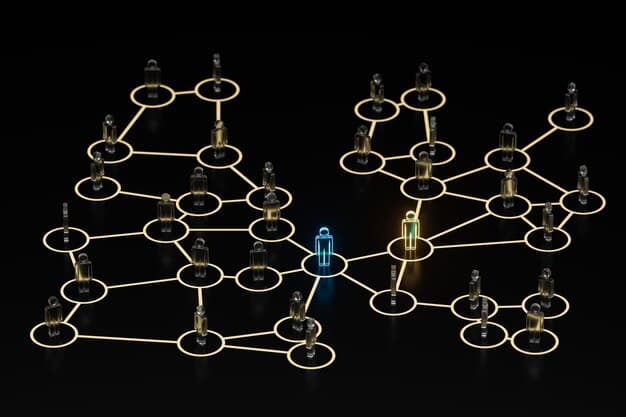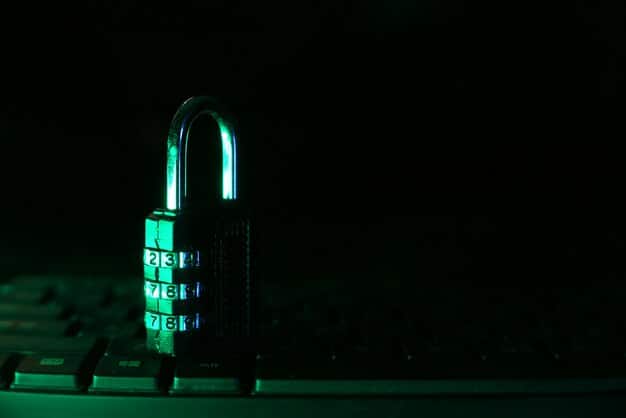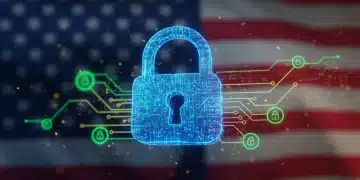The Dark Web: Threats and Protection for Your Organization

The Dark Web poses significant cybersecurity threats to organizations, including data breaches, malware infections, and exposure to illegal activities; therefore, understanding its risks and implementing robust protection measures is crucial.
The Dark Web: Understanding the Threats and How to Protect Your Organization is increasingly crucial in today’s digital landscape, where cyber threats are constantly evolving and becoming more sophisticated. Comprehending the intricacies of the Dark Web is essential for safeguarding sensitive data and maintaining a resilient cybersecurity posture.
What is the Dark Web?
The Dark Web, a subset of the Deep Web, requires specific software, configurations, or authorization to access, making it distinct from the surface web we use daily. Understanding this fundamental difference is the first step in appreciating the challenges it poses.
Unlike the surface web, which search engines index, the Dark Web relies on anonymizing networks that hide IP addresses. This anonymity makes it attractive for both legitimate users seeking privacy and malicious actors engaged in illegal activities.
Key Characteristics of the Dark Web
Several key characteristics define the Dark Web and differentiate it from the regular internet. These include anonymity, encryption, and decentralized infrastructure.
- Anonymity: Users can interact without revealing their identities, which attracts individuals seeking privacy and those involved in illicit activities.
- Encryption: The Dark Web uses advanced encryption techniques to conceal data and communications, making it difficult to trace activities.
- Decentralization: The decentralized infrastructure of the Dark Web, often relying on peer-to-peer networks, makes it resilient to censorship and shutdown attempts.

Understanding these characteristics is crucial for appreciating the challenges and risks associated with the Dark Web. It also highlights the need for specialized tools and techniques to monitor and mitigate threats emanating from this hidden corner of the internet.
In conclusion, the Dark Web’s unique features make it a haven for various threat actors, emphasizing the importance of understanding its structure and operational mechanisms to implement effective cybersecurity strategies.
Common Threats Originating from the Dark Web
The Dark Web serves as a breeding ground for various cyber threats that can significantly impact organizations. Recognizing these threats is vital for developing proactive defense strategies.
From the sale of stolen data to the orchestration of ransomware attacks, the Dark Web presents a multifaceted challenge to cybersecurity professionals. Understanding the types of threats and their potential impact is crucial for implementing effective countermeasures.
Stolen Data Markets
One of the most prevalent threats on the Dark Web is the sale of stolen data. This includes personal information, financial data, and proprietary business information.
These data markets facilitate the buying and selling of compromised credentials, credit card details, and sensitive documents. The availability of this information can lead to identity theft, financial fraud, and significant reputational damage for affected organizations.
Malware and Hacking Tools
The Dark Web is also a hub for malware distribution and the sale of hacking tools. These resources enable cybercriminals to launch sophisticated attacks against vulnerable systems.
- Ransomware: The Dark Web hosts forums where ransomware developers sell or lease their malicious software, enabling attackers to encrypt and extort victims.
- Exploit Kits: Cybercriminals use exploit kits to identify and exploit vulnerabilities in software, allowing them to compromise systems and steal data.
- DDoS Services: Distributed Denial of Service (DDoS) attacks can be purchased on the Dark Web, enabling attackers to overwhelm target servers with traffic and disrupt services.
The accessibility of these tools lowers the barrier to entry for cybercriminals, making it easier to launch devastating attacks. Organizations must continuously monitor their systems for signs of compromise and implement robust security measures to prevent infections.
In summary, the Dark Web’s role in facilitating the trade of stolen data, malware, and hacking tools makes it a critical threat landscape that demands continuous monitoring and proactive security measures to protect organizational assets.

How the Dark Web Impacts Organizations
The impact of the Dark Web on organizations can be profound and far-reaching. The consequences range from financial losses and reputational damage to legal liabilities and operational disruptions.
Understanding the potential ramifications of Dark Web-related threats is essential for prioritizing cybersecurity investments and implementing effective protection strategies. The goal is to mitigate risks and minimize the impact of potential breaches.
Financial and Reputational Damage
One of the most immediate impacts of Dark Web-related incidents is financial loss. This can stem from various sources, including fraud, extortion, and the cost of incident response.
Reputational damage can be equally devastating. Data breaches and cyberattacks can erode customer trust, leading to loss of business and long-term damage to an organization’s brand.
Data Breaches and Legal Liabilities
Data breaches are a significant concern for organizations. The exposure of sensitive data can lead to legal liabilities, regulatory fines, and potential lawsuits.
- Compliance Requirements: Organizations must comply with various data protection regulations, such as GDPR and CCPA, which require them to implement robust security measures and notify authorities and affected individuals in the event of a breach.
- Legal Consequences: Failure to protect sensitive data can result in significant legal penalties, including fines and sanctions.
- Incident Response Costs: Investigating and remediating data breaches can be costly, involving forensic analysis, legal counsel, and public relations efforts.
Organizations must invest in comprehensive data protection strategies to minimize the risk of breaches and ensure compliance with relevant regulations. This includes implementing encryption, access controls, and data loss prevention (DLP) measures.
In conclusion, the financial, reputational, and legal impacts of the Dark Web underscore the critical importance of proactive cybersecurity and vigilance in protecting organizational assets and maintaining stakeholder trust.
Strategies for Protecting Your Organization
Protecting your organization from Dark Web threats requires a multifaceted approach that combines technology, policies, and employee awareness. Implementing a comprehensive security strategy is crucial for mitigating risks and minimizing potential damage.
From proactive monitoring to incident response planning, organizations must adopt a holistic approach to cybersecurity. This includes not only technical measures but also organizational policies and employee training to create a culture of security awareness.
Proactive Monitoring and Threat Intelligence
One of the most effective strategies for protecting against Dark Web threats is proactive monitoring. This involves actively searching for compromised data and potential threats before they can cause harm.
Threat intelligence is a critical component of proactive monitoring. By leveraging threat intelligence feeds and data analytics, organizations can gain insights into emerging threats and vulnerabilities. This information can be used to enhance security measures and prioritize incident response efforts.
Employee Training and Awareness
Employee training and awareness programs are essential for building a strong security culture. Employees are often the first line of defense against cyber threats, so it’s crucial to educate them about the risks and how to recognize and report suspicious activity.
- Phishing Simulations: Conducting regular phishing simulations can help employees identify and avoid phishing scams.
- Security Best Practices: Training should cover security best practices, such as using strong passwords, enabling multi-factor authentication, and avoiding suspicious links and attachments.
- Incident Reporting: Employees should be trained on how to report security incidents promptly and effectively.
By empowering employees with the knowledge and skills to recognize and respond to cyber threats, organizations can significantly reduce their risk exposure. Regular training and awareness programs should be an integral part of any cybersecurity strategy.
In summary, proactive monitoring, threat intelligence, and employee training are essential components of a comprehensive cybersecurity strategy that can help organizations protect themselves from the diverse threats emanating from the Dark Web.
Tools and Technologies for Dark Web Monitoring
Effective Dark Web monitoring requires specialized tools and technologies that can navigate the anonymized networks and identify potential threats. These tools provide valuable insights into the activities and actors operating on the Dark Web.
From automated crawlers to human intelligence gathering, organizations can leverage a variety of tools and techniques to monitor the Dark Web. The selection of appropriate tools will depend on the organization’s specific needs and resources.
Automated Crawlers and Search Engines
Automated crawlers and search engines are used to index and search the Dark Web for specific keywords, data, and patterns. These tools can identify compromised credentials, stolen data, and other potential threats.
These crawlers work by systematically exploring the Dark Web and extracting relevant information. The collected data is then analyzed to identify potential threats and vulnerabilities. However, these tools require careful configuration and maintenance to ensure accuracy and effectiveness.
Human Intelligence and Dark Web Analysts
Human intelligence (HUMINT) involves using skilled analysts to manually investigate and gather information from the Dark Web. This approach can provide deeper insights and context than automated tools alone.
- Undercover Operations: Analysts may participate in online communities and forums to gather information about emerging threats and threat actors.
- Language Skills: Analysts with knowledge of multiple languages can access and analyze a wider range of Dark Web content.
- Contextual Analysis: Human analysts can provide valuable contextual analysis, helping to understand the motivations and tactics of threat actors.
Combining automated tools with human intelligence can provide a more comprehensive and effective Dark Web monitoring capability. This approach allows organizations to not only identify potential threats but also understand their context and potential impact.
In conclusion, leveraging the right tools and technologies, along with human expertise, is crucial for effective Dark Web monitoring and threat mitigation.
Incident Response and Remediation
Even with robust security measures in place, organizations may still experience security incidents related to the Dark Web. Having a well-defined incident response plan is crucial for minimizing the impact of these incidents and ensuring a swift recovery.
Effective incident response involves identifying, containing, eradicating, and recovering from security incidents. A comprehensive incident response plan should outline the roles and responsibilities of key personnel, as well as the steps to take in the event of a breach.
Developing an Incident Response Plan
An incident response plan should include detailed procedures for handling different types of security incidents, including data breaches, malware infections, and ransomware attacks.
The plan should also include mechanisms for communicating with stakeholders, including employees, customers, and regulatory authorities. Transparency and timely communication are essential for maintaining trust and minimizing reputational damage.
Best Practices for Remediation
Remediation involves taking steps to address the root cause of a security incident and prevent future occurrences. This may include patching vulnerabilities, implementing stronger access controls, and enhancing security monitoring capabilities.
- Forensic Analysis: Conducting a thorough forensic analysis can help identify the scope and cause of a security incident.
- System Hardening: Implementing system hardening measures can reduce the attack surface and make it more difficult for attackers to compromise systems.
- Security Audits: Regularly conducting security audits can help identify vulnerabilities and weaknesses in the organization’s security posture.
By following best practices for remediation, organizations can strengthen their security posture and reduce the likelihood of future incidents. A proactive approach to security is essential for protecting against the ever-evolving threats emanating from the Dark Web.
In summary, a well-defined incident response plan and effective remediation strategies are critical for minimizing the impact of Dark Web-related security incidents and ensuring a swift recovery.
| Key Point | Brief Description |
|---|---|
| 🔒 Anonymity | Dark Web enables anonymity, attracting illicit activities. |
| ⚠️ Threats | Stolen data, malware, and hacking tools are common threats. |
| 🛡️ Protection | Proactive monitoring and employee training are essential. |
| 🚨 Incident Response | A clear plan is crucial for minimizing incident impact. |
FAQ
The Dark Web requires specific software for access, ensuring anonymity. Unlike the surface web indexed by search engines, it operates on networks that hide IP addresses, used for privacy or illicit activities.
Common threats include stolen data markets where personal and financial information is sold, distribution of malware like ransomware, and hacking tools that enable cybercriminals to launch sophisticated attacks on vulnerable systems.
Organizations can face financial losses from fraud and extortion, reputational damage due to data breaches eroding customer trust, and legal liabilities from non-compliance with data protection regulations like GDPR and CCPA.
Key strategies include proactive monitoring using threat intelligence to identify emerging threats, comprehensive employee training to recognize phishing scams, and implementing proactive incident response plans to handle security incidents effectively.
Tools include automated crawlers for indexing and searching Dark Web content for key terms or compromised data. Combining automated methods with human analysts gives deeper context into motivations and tactics of threat actors.
Conclusion
In conclusion, understanding the dark web: understanding the threats and how to protect your organization is a critical endeavor for any organization striving to maintain a strong cybersecurity posture. By understanding the inherent risks and taking proactive measures, organizations can significantly reduce their vulnerability and protect their valuable assets. Continuous vigilance, coupled with robust security strategies, is essential for navigating the complexities of the digital landscape and safeguarding against potential threats.





